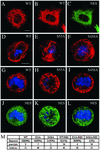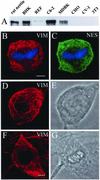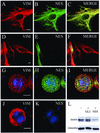Nestin promotes the phosphorylation-dependent disassembly of vimentin intermediate filaments during mitosis
- PMID: 12686602
- PMCID: PMC153115
- DOI: 10.1091/mbc.e02-08-0545
Nestin promotes the phosphorylation-dependent disassembly of vimentin intermediate filaments during mitosis
Abstract
The expression of the intermediate filament (IF) protein nestin is closely associated with rapidly proliferating progenitor cells during neurogenesis and myogenesis, but little is known about its function. In this study, we examine the effects of nestin expression on the assembly state of vimentin IFs in nestin-free cells. Nestin is introduced by transient transfection and is positively correlated with the disassembly of vimentin IFs into nonfilamentous aggregates or particles in mitotic but not interphase cells. This nestin-mediated disassembly of IFs is dependent on the phosphorylation of vimentin by the maturation/M-phase-promoting factor at ser-55 in the amino-terminal head domain. In addition, the disassembly of vimentin IFs during mitosis appears to be a unique feature of nestin-expressing cell types. Furthermore, when the expression of nestin is downregulated by the nestin-specific small interfering RNA in nestin-expressing cells, vimentin IFs remain assembled throughout all stages of mitosis. Previous studies suggest that nonfilamentous vimentin particles are IF precursors and can be transported rapidly between different cytoplasmic compartments along microtubule tracks. On the basis of these observations, we speculate that nestin may play a role in the trafficking and distribution of IF proteins and potentially other cellular factors to daughter cells during progenitor cell division.
Figures







Similar articles
-
Structural changes in intermediate filament networks alter the activity of insulin-degrading enzyme.FASEB J. 2009 Nov;23(11):3734-42. doi: 10.1096/fj.09-137455. Epub 2009 Jul 7. FASEB J. 2009. PMID: 19584300 Free PMC article.
-
Cell cycle-dependent changes in the organization of an intermediate filament-associated protein: correlation with phosphorylation by p34cdc2.Proc Natl Acad Sci U S A. 1992 Dec 15;89(24):11959-63. doi: 10.1073/pnas.89.24.11959. Proc Natl Acad Sci U S A. 1992. PMID: 1281546 Free PMC article.
-
Mitotic reorganization of the intermediate filament protein nestin involves phosphorylation by cdc2 kinase.J Biol Chem. 2001 May 11;276(19):16456-63. doi: 10.1074/jbc.M009669200. Epub 2001 Feb 1. J Biol Chem. 2001. PMID: 11278541
-
Nestin structure and predicted function in cellular cytoskeletal organisation.Histol Histopathol. 2005 Apr;20(2):665-71. doi: 10.14670/HH-20.665. Histol Histopathol. 2005. PMID: 15736068 Review.
-
Role of phosphorylation on the structural dynamics and function of types III and IV intermediate filaments.Exp Cell Res. 2007 Jun 10;313(10):2098-109. doi: 10.1016/j.yexcr.2007.04.010. Epub 2007 Apr 12. Exp Cell Res. 2007. PMID: 17498690 Free PMC article. Review.
Cited by
-
The Diversity of Intermediate Filaments in Astrocytes.Cells. 2020 Jul 2;9(7):1604. doi: 10.3390/cells9071604. Cells. 2020. PMID: 32630739 Free PMC article. Review.
-
Desmin aggregate formation by R120G alphaB-crystallin is caused by altered filament interactions and is dependent upon network status in cells.Mol Biol Cell. 2004 May;15(5):2335-46. doi: 10.1091/mbc.e03-12-0893. Epub 2004 Mar 5. Mol Biol Cell. 2004. PMID: 15004226 Free PMC article.
-
The Serine/threonine kinase Stk33 exhibits autophosphorylation and phosphorylates the intermediate filament protein Vimentin.BMC Biochem. 2008 Sep 23;9:25. doi: 10.1186/1471-2091-9-25. BMC Biochem. 2008. PMID: 18811945 Free PMC article.
-
Motor Improvement of Skilled Forelimb Use Induced by Treatment with Growth Hormone and Rehabilitation Is Dependent on the Onset of the Treatment after Cortical Ablation.Neural Plast. 2018 Mar 20;2018:6125901. doi: 10.1155/2018/6125901. eCollection 2018. Neural Plast. 2018. PMID: 29755514 Free PMC article.
-
Expression Pattern of the Cancer Stem Cell Marker "Nestin" in Leukoplakia and Oral Squamous Cell Carcinoma.Rambam Maimonides Med J. 2019 Oct 29;10(4):e0024. doi: 10.5041/RMMJ.10378. Rambam Maimonides Med J. 2019. PMID: 31675305 Free PMC article.
References
-
- Aubin JE, Osborn M, Franke WW, Weber K. Intermediate filaments of the vimentin-type and the cytokeratin-type are distributed differently during mitosis. Exp Cell Res. 1980;129:149–165. - PubMed
-
- Bellin RM, Sernett SW, Becker B, Ip W, Huiatt TW, Robson RM. Molecular characteristics and interactions of the intermediate filament protein synemin: interactions with alpha-actinin may anchor synemin-containing heterofilaments. J Biol Chem. 1999;274:29493–29499. - PubMed
-
- Chou YH, Bischoff JR, Beach D, Goldman RD. Intermediate filament reorganization during mitosis is mediated by p34cdc2 phosphorylation of vimentin. Cell. 1990;62:1063–1071. - PubMed
-
- Chou YH, Opal P, Quinlan RA, Goldman RD. The relative roles of specific N- and C-terminal phosphorylation sites in the disassembly of intermediate filament in mitotic BHK-21 cells. J Cell Sci. 1996;109:817–826. - PubMed
Publication types
MeSH terms
Substances
LinkOut - more resources
Full Text Sources
Other Literature Sources
Molecular Biology Databases
Miscellaneous

